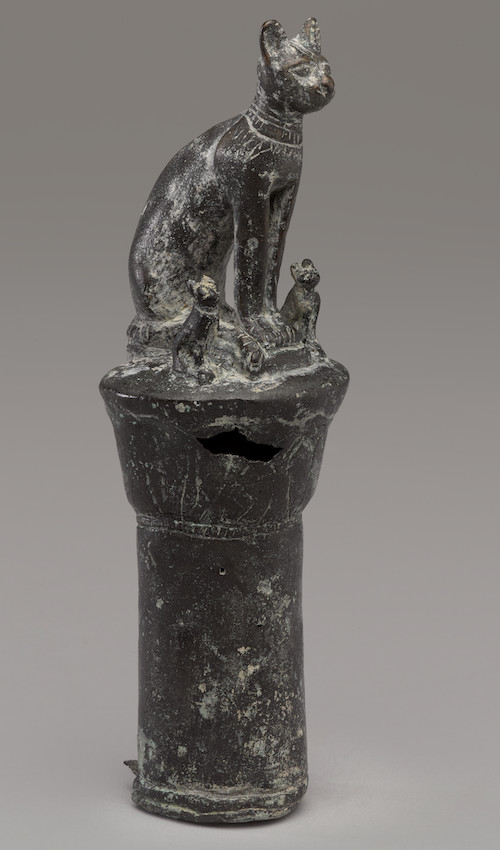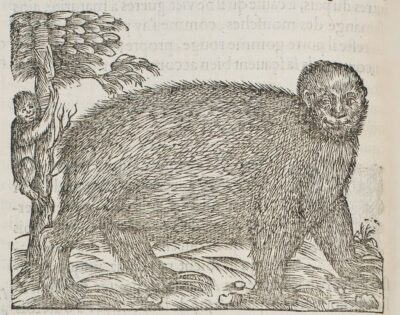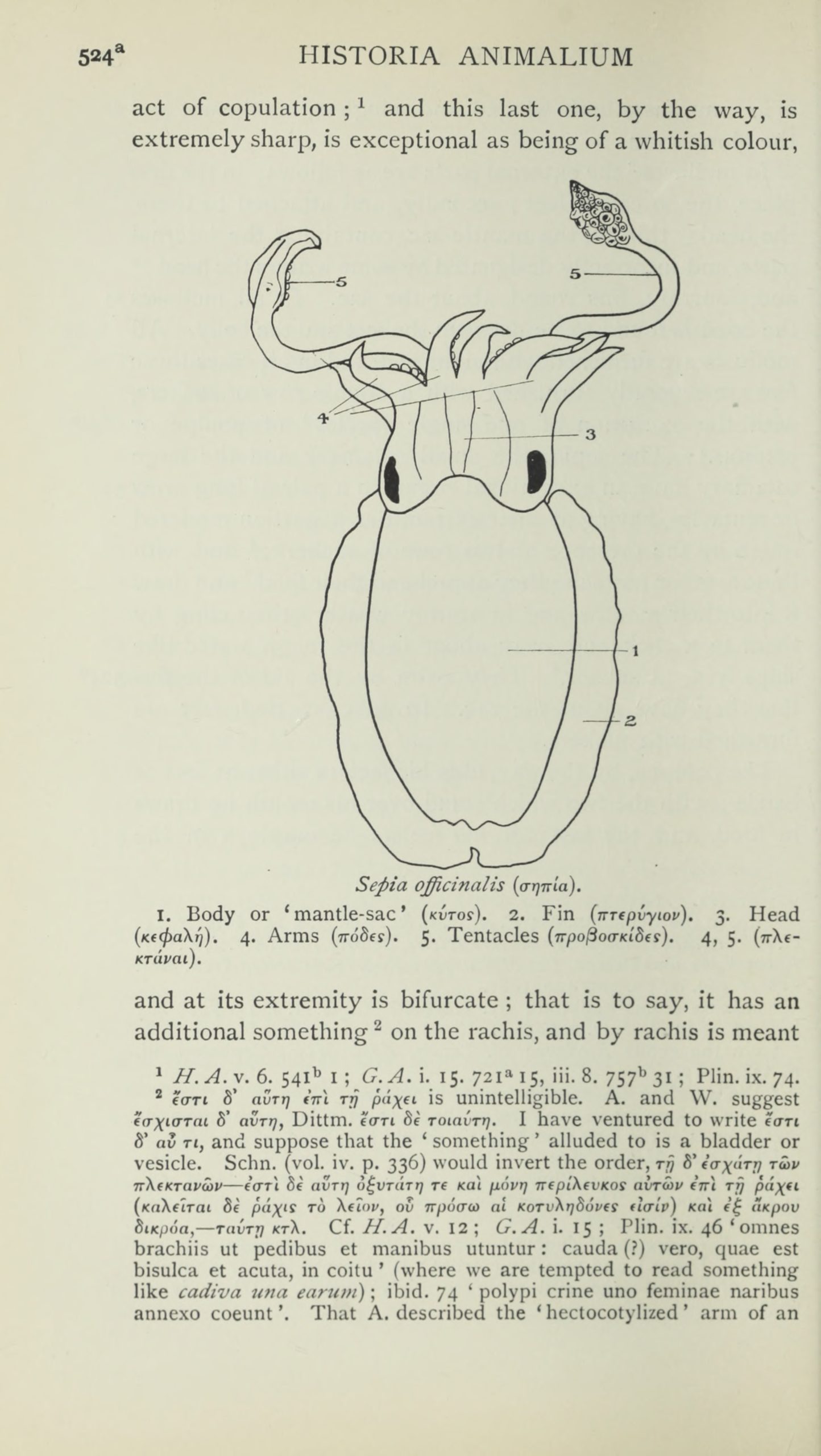| Creator | Unknown |
| Media Form | Sculpture |
| Genre | Ancient Near Eastern Art |
| Technique | Bronze sculpture |
| Date/Location of Creation | 664-30 B.C.E.; Ancient Egypt |
| Publication Information | Object held at the Brooklyn Museum. The digital image of this sculpture is licensed by CC-BY |
| Species Represented | Cat (Felis Catus) |
Cats are arguably the most regal-looking of all domesticated animals. I mean in Ancient Egypt, they would often get buried with their cats and loved the creatures. Specifically, as pictured above, they often showed the Goddess Bastet represented as a cat in artwork. Known for protecting one’s home and family, she was a very popular Egyptian God. There was even a yearly festival in honor of Bastet.
In my research, I noticed that the Brooklyn Museum had stated in their description that it was most likely a votive offering. According to the UCLA Encylopedia of Egyptology, as a way of showing their love and honoring a deity, people would often dedicate objects to them, which they would showcase in temples, cemeteries, etc. This ties into the festival previously mentioned since people would often bring presents there, which was probably a votive offering. Scholar Richard H. Wilkison writes of these gifts:
Amulets of cats and litters of kittens were popular New Year gifts, and the name of Bastet was often inscribed on small ceremonial ‘New Year flasks’, probably to evoke the goddess as a bestower of fertility’- and because Bastet, like other lioness goddesses, was viewed as a protective deity able to counter the darker forces associated with the ‘Demon Days’ at the end of the Egyptian year.
The Complete Gods And Goddesses Of Ancient Egypt (p. 179)
While the Bastet and other feline Gods were represented as motherly, nurturing figures, they also had a more violent side to their protection, similar to how a mother bear would protect their cubs. They would burn, destroy, or scratch anyone who would come in their way or try to hurt their family. This is most likely from the actual nature of cats, as they are typically very sweet and loving animals unless you do something that seems threatening to them, which would be a harrowing outcome for the person.
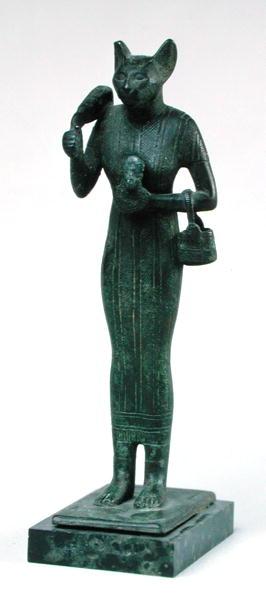
I love how Ancient Egypt viewed cats. While they did not worship like actual living cats, they did view them as divine beings and protectors. What is very interesting to me is how the Goddess Bastet is represented by different forms of artwork at the time. In the representation shown above, she is a literal cat, but sometimes she is represented as a woman with the head of a cat, as shown above. This ties into how the Goddess represented fertility and childbirth. Most likely in Ancient Egypt, they viewed women as the protectors of their homes along with cats and this then caused them to create statues of said Goddess as a woman with a cat head.
These bronze statues as shown above were created using a very specific practice done by Ancient Egyptians called the lost-wax casting technique. This began with the formation of a wax model representing their intended sculpture, which was then covered in clay. The clay mold underwent a heating process, causing the wax to melt away and leave behind an empty cavity. To complete the sculpture, they would pour melted bronze into the cavity, and once the metal solidified, the mold was fractured to unveil the final bronze artwork.
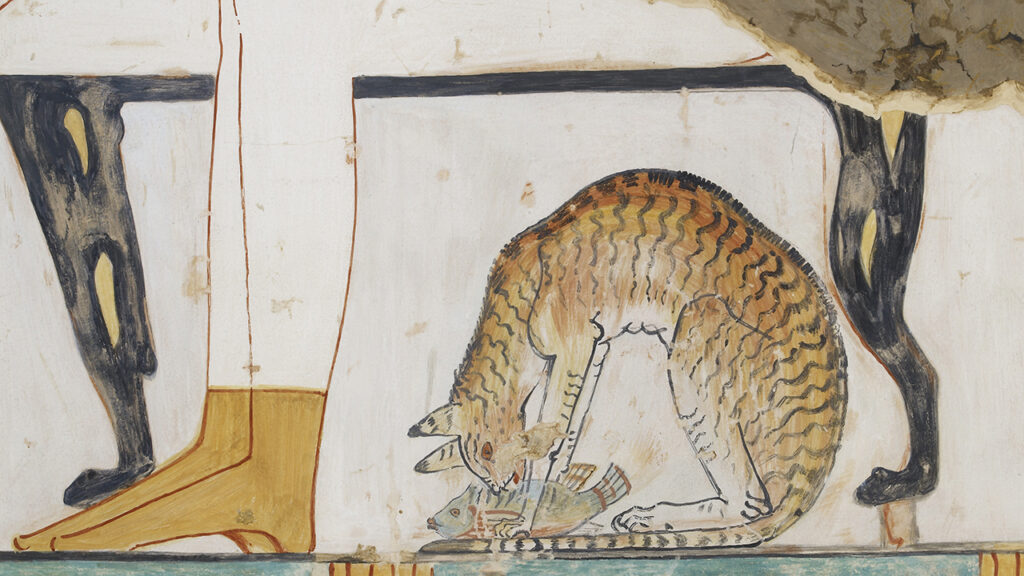
The domestication of cats in ancient Egypt appears to be woven into the fabric of their religious beliefs. Although there might not be direct historical evidence linking the act of domestication to their religious practices, I believe there is a correlation when considering the love ancient Egyptians had for feline animals. Cats were often perceived as the earthly representations of their deities, embodying qualities associated with gods. In this cultural context, it would make logical sense that these animals, considered sacred, were given special treatment by humans. The notion that cats were associated with gods led Egyptians to view them not merely as pets but as divine companions, deserving of care and sustenance. The act of providing food and favorable treatment to these feline companions could be tied to the act of offerings that were given to deities at this time. In ancient Egypt, offerings to deities were a crucial aspect of their religious practices, reflecting a deep connection between the earthly and divine realms. These offerings, known as “shai,” included a diverse array of items such as food, drink, incense, and symbolic objects. It is an extremely important thing to note that Ancient Egyptians are credited with the domestication of the cats we know today. In an article posted by Nature: Ecology & Evolution, they do DNA research to understand the evolution of cats and where they originated from. They believe that the domesticated cats we know today originate from wildcats that most likely came from the Near East and Ancient Egypt using their DNA and how it has evolved since the 12th century. Also, they provide evidence of the artwork, such as the one shown above, where cats are seen living in co-existence with humans.
Work Cited
Barbash, Yekaterina. “Cats, Bastet and the Worship of Feline Gods.” ARCE, 2023, arce.org/resource/cats-bastet-and-worship-feline-gods/.
“Brooklyn Museum.” Www.brooklynmuseum.org, www.brooklynmuseum.org/opencollection/objects/17380. Accessed 6 Oct. 2023.
Pinch, Geraldine, and Elizabeth A. Waraksa. “Votive Practices.” UCLA Encyclopedia of Egyptology, vol. 1, no. 1, June 2009, escholarship.org/uc/item/7kp4n7rk.
Mark, Joshua J. “Bastet.” World History Encyclopedia, 24 July 2016, www.worldhistory.org/Bastet/.
H. Wilkinson, Richard. “The Complete Gods and Goddesses of Ancient Egypt.” Internet Archive, Thames & Hudson, 2003, archive.org/details/TheCompleteGodsAndGoddessesOfAncientEgypt/The%20Complete%20Gods%20and%20Goddesses%20of%20Ancient%20Egypt/page/n177/mode/2up. Accessed 6 Oct. 2023.
Louvre. “Goddess Bastet Figurine.” Musée Du Louvre, 21 Feb. 2023, collections.louvre.fr/en/ark:/53355/cl010007087. Accessed 10 Dec. 2023.
“Norman de Garis Davies | Banquet Scene with Musicians, Tomb of Nakht | Twentieth Century; Original New Kingdom.” The Metropolitan Museum of Art, www.metmuseum.org/art/collection/search/548576.
Ottoni, Claudio, et al. “The Palaeogenetics of Cat Dispersal in the Ancient World.” Nature Ecology & Evolution, vol. 1, no. 7, June 2017, https://doi.org/10.1038/s41559-017-0139.
